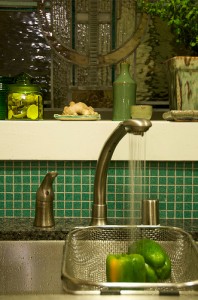When I first started writing about toxic chemicals, a funny thing would happen. Every few weeks, after devouring a new study or
article, I would race through my apartment, bagging up the series of surprisingly toxic products that lived in each room. At the end of this mad dash, my sense of accomplishment quickly turned into a sense of doom: There was no way I could afford to replace everything. Actually, at that point, there was no way I could afford to replace anything. Those bags never made it to the garbage can; I unpacked them every time.
Taking toxic chemicals out of your home can feel incredibly overwhelming. But you don't have to throw everything away, and you don't have to throw out your budget. Take small steps. Make changes that make sense for your budget. Don't be too hard on yourself. Over time, I stopped making that frenzied, and ultimately unhelpful, race through my apartment. Instead, I found simple, inexpensive (often free) changes I could make to take toxic chemicals out of my home. Recently, we discussed easy tips to give your bathroom a non-toxic makeover. This week, lets take a look at simple solutions for taking toxic chemicals out of your kitchen
Cleaning supplies: Give your kitchen cleaning supplies an inexpensive nontoxic upgrade by making DIY versions (don’t worry: these are simple, two ingredient fixes):
- Garbage Disposal Cleaner:Try this recipe from the Smart Mama--Combine water and distilled white vinegar in ice cube trays and use the frozen cubes as a homemade disposal cleaner.
- Sink cleaner: Use Savvy Brown’s sink cleaning solution by scrubbing a dirty sink with a simple mix of vineger and baking soda.
- Oven cleaner: A simple paste made from baking soda and water is an excellent oven cleaner. Follow these steps from Healthy Child, Healthy World to clean your oven the non-toxic way.
Cooking materials: One easy way to reduce toxics in your cookware is to think about which pot or pan you use the most and focus on making that the safest. If you are in the market for new cookware, try these tips on materials from Planet Home:
- Glass: Ovenproof glass is “inexpensive, reusable, and recyclable.” While it's great for baking, most glass can not be used on the stove.
- Ceramic: Make sure it’s lead-free, and skip painted ceramic dishes in particular unless you're certain that they don't contain lead.
- Stainless steel: Aim for completely stainless steel if possible; these versions are the least likely to leach components into cooking foods.
Other durable, nontoxic materials include cast iron, copper, and enamel-coated cast iron. If you are currently using pans with a nonstick coating, make sure to replace them once the coating has been scratched or torn.
Tap water: If you're in the market for a water filter, the Environmental Working Group’s water filter guide will help you choose the filter that’s right for you and your budget needs. If not, there are a few easy tips you can use to make your tap water safer:
- Always cook with and drink cold water from the tap.
- Let water for a minute in the morning before you use it.
- The Green Guide recommends placing an open container of water in the fridge for a few hours, which helps filter out chlorine, and let water run for a full minute before you use it for cooking or drinking.
Wash everything thoroughly: The best way to detox your fruits and veggies is to make sure they're thoroughly cleaned so that you're not consuming any chemicals that are lingering on the skin. This is especially important for non-organic produce.
- Rub your fruits and veggies for 30 to 60 seconds under warm running water. Not sure how to time 30 seconds? It's about the length of time it takes to sing "Happy Birthday" twice in your head.
- Wash inedible peels; even though you discard the peel, cutting into the fruit or peeling the fruit can transfer chemicals into the fruits flesh through your knife.
- Try a scrub, but don't waste money on pricey commercial versions. Check out this guide to washing produce by Mama in the Kitchen; it has two simple, vinegar based and salt based scrubs that you can make at home.
Making the most of your produce: Fruits and vegetables are an essential part of any healthy diet. Try to choose the healthiest produce for your budget, and make it last, with these easy tips:
- The Dirty Dozen is a list by the Environmental Working Group of the most highly pesticide contaminated fruits and vegetables. If you can't buy organic versions of these items, that's okay. Try to reduce your consumption of them if possible and make sure to stringently follow the cleaning tips listed above. Or, swap out Dirty Dozen items with produce from the Clean 15; this list from the Environmental Working Group shows the conventionally grown fruits and veggies with the least pesticide contamination.
- This guide shows you how to store fruits and vegetables so they’re less likely to spoil quickly, and how soon you should eat them after purchase.
- If you find a great deal at your local supermarket on organic produce, why not create your own frozen food? The National Center for Home Food Preservation gives you a rundown of how to freeze specific fruits and vegetables so you can store and freeze your produce safely.




The views and opinions expressed in this post are those of the author(s) and do not necessarily reflect those of MomsRising.org.
MomsRising.org strongly encourages our readers to post comments in response to blog posts. We value diversity of opinions and perspectives. Our goals for this space are to be educational, thought-provoking, and respectful. So we actively moderate comments and we reserve the right to edit or remove comments that undermine these goals. Thanks!